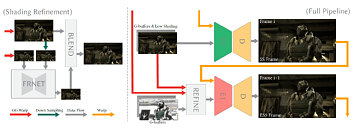- Joined
- Oct 9, 2007
- Messages
- 47,648 (7.44/day)
- Location
- Dublin, Ireland
| System Name | RBMK-1000 |
|---|---|
| Processor | AMD Ryzen 7 5700G |
| Motherboard | Gigabyte B550 AORUS Elite V2 |
| Cooling | DeepCool Gammax L240 V2 |
| Memory | 2x 16GB DDR4-3200 |
| Video Card(s) | Galax RTX 4070 Ti EX |
| Storage | Samsung 990 1TB |
| Display(s) | BenQ 1440p 60 Hz 27-inch |
| Case | Corsair Carbide 100R |
| Audio Device(s) | ASUS SupremeFX S1220A |
| Power Supply | Cooler Master MWE Gold 650W |
| Mouse | ASUS ROG Strix Impact |
| Keyboard | Gamdias Hermes E2 |
| Software | Windows 11 Pro |
With both NVIDIA and AMD having the ability to nearly double frame-rates in games using frame generation technologies such as DLSS 3 and FSR 3, Intel Graphics couldn't be too far behind. The company is taking a significantly different approach than the other two GPU makers. In a research paper titled "ExtraSS Framework Details Intel's Take on Frame Generation," Intel provides an overview of how ExtraSS works, and its obvious advantage over DLSS 3 and FSR 3—latency.
ExtraSS is a technology that relies on frame extrapolation, instead of interpolation on FSR 3 and DLSS 3. In interpolation, the software uses past- and future frames to guess an in-between frame, using motion vectors and temporal data. This adds latency, which is why NVIDIA and AMD rely on technologies such as Reflex and Anti-Lag+ to mitigate it. There's no such technological problem to solve with ExtraSS. On the other hand, generating frames entirely using past frames (i.e. extrapolation in the literal sense of the word), can result in artifacts and ghosting. Intel intends to solve this using a new warping method, and AI. ExtraSS should come in particularly handy as Intel is betting big on giving its processors powerful iGPUs, such as the Xe-LPG powering the Core Ultra "Meteor Lake," while its Arc "Alchemist" GPUs remain a generation older than what NVIDIA and AMD have in the dGPU market. Intel hopes to launch its next-generation "Battlemage" discrete GPUs in 2024.



View at TechPowerUp Main Site | Source
ExtraSS is a technology that relies on frame extrapolation, instead of interpolation on FSR 3 and DLSS 3. In interpolation, the software uses past- and future frames to guess an in-between frame, using motion vectors and temporal data. This adds latency, which is why NVIDIA and AMD rely on technologies such as Reflex and Anti-Lag+ to mitigate it. There's no such technological problem to solve with ExtraSS. On the other hand, generating frames entirely using past frames (i.e. extrapolation in the literal sense of the word), can result in artifacts and ghosting. Intel intends to solve this using a new warping method, and AI. ExtraSS should come in particularly handy as Intel is betting big on giving its processors powerful iGPUs, such as the Xe-LPG powering the Core Ultra "Meteor Lake," while its Arc "Alchemist" GPUs remain a generation older than what NVIDIA and AMD have in the dGPU market. Intel hopes to launch its next-generation "Battlemage" discrete GPUs in 2024.



View at TechPowerUp Main Site | Source




